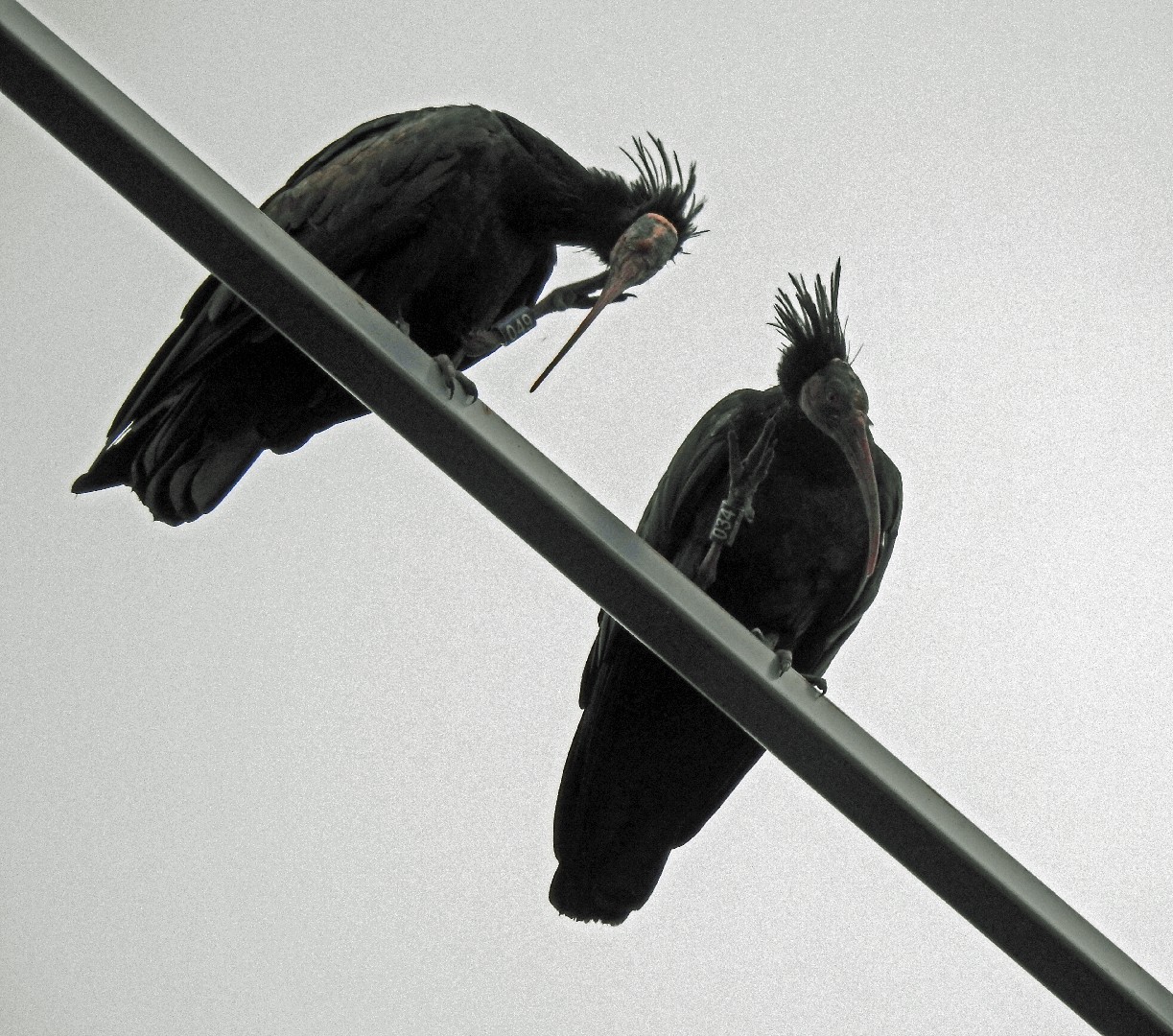Northern Bald Ibis
A species of Bald ibises, Also known as Hermit Ibis Scientific name : Geronticus eremita Genus : Bald ibises
Northern Bald Ibis, A species of Bald ibises
Also known as:
Hermit Ibis
Botanical name: Geronticus eremita
Genus: Bald ibises
Content
Description People often ask General Info
 Photo By Wald1siedel , used under CC-BY-SA-4.0 /Cropped and compressed from original
Photo By Wald1siedel , used under CC-BY-SA-4.0 /Cropped and compressed from original Description
The northern bald ibis is a large, glossy black bird, 70–80 cm (28–31 in) long with a 125–135 cm (49–53 in) wingspan and an average weight of 1.0–1.3 kg (35–46 oz). The plumage is black, with bronze-green and violet iridescence, and there is a wispy ruff on the bird's hind neck. The face and head are dull red and unfeathered, and the long, curved bill and the legs are red. In flight, this bird has powerful, shallow, and flexible wing beats. It gives guttural hrump and high, hoarse hyoh calls at its breeding colonies, but is otherwise silent. The sexes are similar in plumage, although males are generally larger than females, and, as with other ibises that breed in colonies, have longer bills. The longer-billed males are more successful in attracting a mate. The downy chick has uniformly pale brown plumage, and the fledged juvenile resembles the adult except that it has a dark head, light grey legs, and a pale bill. The unfeathered areas of the young bird's head and neck gradually become red as it matures. Moroccan birds have a significantly longer bill than Turkish birds of the same sex. If the eastern and western populations are considered to be separable subspecies, it is unclear which should be considered to be the nominate (first-named) form, since the first description of this species was based on a now-extinct population from Switzerland which is of unknown race. The northern bald ibis is readily distinguished from its close relative, the southern bald ibis of Southern Africa, by the southern species' whitish face. The northern bald can also be confused with the similarly dark-plumaged glossy ibis, which overlaps its range, but it is larger and stockier than that species. In flight, when the bill and face colouration may not be visible, the bald ibis' less rounded wings and shorter neck give it a different profile from glossy ibis, and its relatively short legs mean that its feet do not project beyond the tail, unlike those of the glossy ibis. 
Size
80 cm
Life Expectancy
25 years
Nest Placement
Cliff
Feeding Habits
Northern Bald Ibis is an omnivorous forager, feeding on a variety of insects, including grasshoppers and beetles, small animals like reptiles and mammals, as well as plant matter such as berries. It possesses unique adaptations like a long bill to probe soil for food.
Habitat
Northern Bald Ibis thrives in arid to semi-arid conditions, often near water sources such as rivers or coastlines. These birds prefer rocky landscapes, including plateaus, plains, and cliffs, but also adapt to areas with human structures. Their habitats span from lowland fields to high-altitude meadows, across various broad regions, and at elevations ranging from 400 to 2750 meters.
Dite type
Omnivorous
People often ask
General Info
Feeding Habits
Bird food type
Species Status
Although the northern bald ibis was long extinct in Europe, many colonies in Morocco and Algeria survived until the early 20th century, when they began to decline more rapidly, the last colony in Algeria disappearing in the late 1980s. In Morocco there were about 38 colonies in 1940 and 15 in 1975, but the last migratory populations in the Atlas Mountains had vanished by 1989. The species is endangered according to the IUCN scale, with an estimated population in 2018 of around 147 breeding pairs in the wild and over 1,000 in captivity. It was formerly considered critically endangered until heavy conservation action secured the breeding sites in Morocco and even allowed the birds to expand to other sites, as well as the semi-wild population conserved in Turkey as well as the reintroduction projects in Europe. The northern bald ibis is one of the key species to which the draft Agreement on the Conservation of African-Eurasian Migratory Waterbirds (AEWA) applies, and it has a detailed, internationally agreed conservation action plan under the agreement. As a species that is threatened with extinction, it is listed on Appendix 1 of CITES (the Convention on International Trade in Endangered Species of Wild Fauna and Flora), which means that trade in wild-caught birds is illegal, and may be licensed only in exceptional circumstances. The northern bald ibis has declined for several centuries, at least partly as a consequence of unidentified natural causes. The more rapid decline in the past hundred years, with a loss of 98% of the population between 1900 and 2002, is the result of a combination of factors. These include significant human persecution, especially hunting, and also the loss of steppe and non-intensive agricultural areas (particularly in Morocco), pesticide poisoning, disturbance, and dam construction. The discovery in Jordan of three dead adults from the Turkish colony seemed to confirm that the overuse of pesticides is still a cause of death on migration. These birds were tracked by satellite after leaving Birecik; they stopped off briefly at the Syrian colony, and were later found dead in the Jordanian desert. Although the cause of death was initially thought to have been from poison, probably laid by chicken farmers to kill rodents, the autopsy revealed that they had actually been electrocuted whilst standing on electricity pylons 
Scientific Classification
Phylum
Chordates Class
Birds Order
Pelicans and Relatives Family
Ibises and spoonbills Genus
Bald ibises Species
Northern Bald Ibis